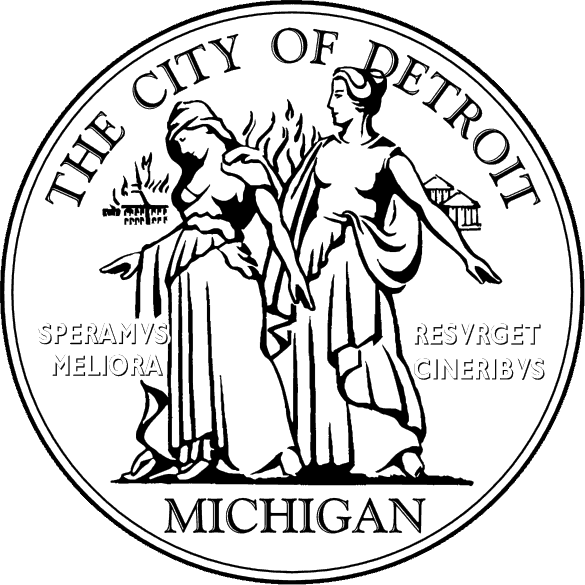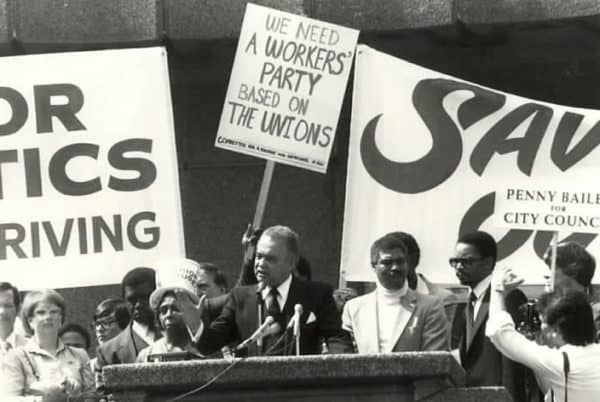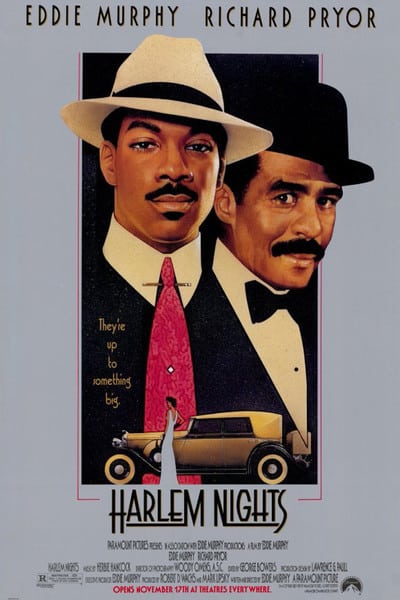The Late Great City of Detroit
William Robertson Boggs, American Renaissance, August 1991

Every year, at Halloween, the city of Detroit goes up in flames. In an annual observance known as Devil’s Night, gangs of young blacks set fire to hundreds of buildings, while fire trucks scream helplessly from one conflagration to the next. Devil’s Night has become a choice event for fire buffs, who come from as far as Europe and Japan to gape at the spectacle of a city gone mad.
The tradition of Devil’s Night arson began for unknown reasons in 1983 and caught the city by surprise. Fires blazed out of control, and smoke hung over the city for days. Now, every year, the city braces for the worst. Fire departments from neighboring suburbs converge on Detroit to help fight the flames, and thousands of civilian volunteers patrol the streets for arsonists. Nothing works. Last year, more fires were set than the year before. Much of the city now looks as if it had been carpet bombed.
Capital of Black America
In Detroit, appearance is a faithful reflection of reality. The city is one of the most wretched, dangerous, ugly, and dispirited in the country. Every year, it competes with Washington (DC) for the distinction as murder capital of the United States. Neighborhood merchants do business behind bullet-proof barriers and leave their stores with weapons drawn.
Of the approximately 20,000 children who start first grade every year, only 500 (2.5%) will ever get enough education to do college work, and only 100 of these will be boys. One third of Detroit’s residents are on public assistance, and food stamps are a virtual second currency. Drugs are everywhere, and the city has black-Africa rates of AIDS and infant mortality. Detroit, the sixth largest city in America, is more than 70 percent black. It thinks of itself as the African-American capital of the continent.
Only a little over a generation ago, the city was a proud, prosperous, mainly-white metropolis — the motor capital of the world. Incongruous as it may now seem, in the mid-1960s, it was widely hailed as an urban success story. The Washington Post wrote that Jerry Cavanaugh, then mayor, “has succeeded where other big city mayors have failed.” Time magazine wrote that he was “restoring the heart”of the city. Detroit was a show piece for Lyndon Johnson’s “great society,”and prided itself on its liberal progressiveness. When Martin Luther King visited Detroit in 1963, he was given a hero’s welcome.
The Illusion Ends
Show piece Detroit fell apart in 1967. That summer, as they had in so many other cities, black neighborhoods erupted in a frenzy of violence and rapine. Detroit’s riots were the worst the country has seen this century. They went on for five days and left 43 people dead. The 101st and 82nd Airborne divisions had to be called in to restore order.
Detroit never recovered from those five days in 1967. Whites have fled the city; in the 20 years following the riots, Detroit lost 600,000 people. The 70 percent white majority of 1960 dropped so quickly that in 1973 Detroit had both a black majority and a black mayor. Now, no other city in the United States has a character or identity that is so clearly black. Mayor Coleman Young calls himself “the black mayor of a black city.”

Mayor Coleman Young in 1981. (Credit Image: Einar Einarsson Kvaran / Wikimedia)
This is scarcely an exaggeration. The police chief and all four police commissioners are black. The school superintendent is black, as are the heads of virtually every city department. Both of the city’s congressmen and most of its judges are black.
While federal and state subsidies keep Detroit from complete collapse, Mayor Young operates his city much as an African potentate might. His picture hangs in every city office building, and his name graces the municipal letterhead. The personal business cards of every city employee bear the mayor’s name. At every opportunity, he names parks and civic centers after himself. Even the city zoo is now named for Coleman A. Young.
The very history of the city now has something of a colonial-African hue. The period of prosperity before the riots is now officially viewed as analogous to colonization. A city document describes the pre-1967 police force as “a hostile white army, entrusted by white authorities with the job of keeping nonwhites penned up in ghettos.” As the riots recede further into the past, they are increasingly seen as a glorious insurrection, in which the oppressed black man threw off his shackles and wrested control from the white man.
Detroit even has its own anthem, which is also the unofficial anthem of black America: Lift Every Voice and Sing. The people of Detroit still sing the Star Spangled Banner when the presence of whites makes it necessary, but it is invariably followed by an enthusiastic chorus of what Detroiters call “our”anthem. No city in America is more self-consciously black, no city more clearly and completely governed by blacks than Detroit.
A Series of Failures
Black rule has not been a success. As the city’s population shifted, all indices of its health went sour. The murder rate rose 1000 percent between 1950 and 1990. Welfare became the single largest employer. Industry escaped to the suburbs, and the tax base shrank.
Despite massive, Devil’s-Night destruction of housing stock, the building industry withered to nearly nothing; in 1987, the city issued only two building permits for single-family houses. As the population shrank to one half its 1950 figure and arson leveled entire blocks, large tracts of the city simply reverted to nature. Wildfowl not normally seen in cities have been found nesting in Detroit’s urban prairies. In the center of town, skyscrapers stand vacant. One can easily walk an entire downtown block, on a week day, and not see a soul.
Of all the city’s horrors, violent crime is surely the worst. People who live in Detroit are two and three times more likely to kill each other than people who live in New York or Chicago. Detroit’s murder statistics are so grim that they push the entire state into the top of the league for black homicide. In the 15-24 age bracket, 232 black men for every 100,000 can expect to be killed every year. Washington (DC) trails far behind at 139. For whites of the same age, the murder rate in Michigan is 6.6 per 100,000, which means the state is 35 times more dangerous for young blacks than it is for young whites. Virtually all blacks are killed by other blacks.
Although it is nearly impossible for anyone not familiar with the city to imagine the texture of life in Detroit, a recent incident at a movie theater captures the atmosphere. When the Americana 8 theater had its first showing of the Eddie Murphy movie, Harlem Nights, the crowd was so large and unmanageable that ushers stopped checking for tickets. Nearly 1,500 people pushed into the theater, filling the seats and aisles. As they waited for the movie to begin, some people passed around bottles of liquor, and others danced on the stage in front of the movie screen. The theater manager was worried by the unruly crowd, and started the movie with the house lights on.

A few minutes into the movie, some men got into a fist fight. The manager stopped the show and called the police, who restored quiet. Shortly after the movie started up again, a group of women began fighting and the movie was stopped. Theater personnel were able to make peace and the movie started again. Yet another fight broke out, the movie was stopped, order was restored, and the movie started up again. Then, just as the Eddie Murphy movie character loosed a burst of gunfire, someone in the audience started firing.
Two men in the theater were wounded, and most of the audience ran out of the building in a panic. One woman was in such a rush that she was hit by a passing car and badly injured. When police and first aid personnel arrived, they were duly fired on. They returned fire, wounding their assailant. It would be wrong to call this a typical Friday night at the movies, but the city has long gone numb to savagery of this kind.
In Detroit, it is sensible to assume that virtually every man is armed — non-criminals must defend themselves against criminals. In one famous incident a few years ago, a bus load of 19 black preachers took an excursion across the border into Canada. They were stopped and searched by customs agents, who discovered 19 hand guns — one per clergyman.
Who is Responsible?
A great city does not become a wasteland without a reason. When the once-great city is populated and governed almost entirely by blacks, one might think that the official and obligatory explanation for black failure — white racism — rings hollow. One would be wrong.
Mayor Young has developed the well-timed charge of racism into a fine art. He dismisses any criticism of the city by white-owned newspapers or television stations as racism. Despite the fact that Detroit no longer has any whites in positions of power — indeed, scarcely any whites at all — Mayor Young regularly wins reelection on the theme that white malevolence is at the root of the city’s problems. Even when whites are out of sight and out of power they are believed to be casting a miasma of despair over what would otherwise be an African-American paradise. In fact, without the welfare and surrounding infrastructure of a rich white nation, Detroit might well be no different from Haiti.
For anyone willing to seek instruction in contrasts, there is much to be learned about Detroit from the city of Toronto. Only 230 miles away, on the shore of Lake Erie rather than Lake Ontario, Toronto has become the city that Detroit once was. While Detroit’s population was dropping by half, from nearly two million to one million, Toronto’s doubled from one million to two million. It weathered declines in its old manufacturing base and found a new role as a center of finance. Safe, bright, upbeat, described by admirers as “New York run by the Swiss,” Toronto could hardly be a more striking contrast to the squalor of Detroit. It is only eleven percent black.
Even though whites dare not discuss the obvious connection between a city’s racial composition and its level of culture, blacks are freer to state the obvious. In Ze’ev Chafets’ recent book on Detroit, Devil’s Night, the author quotes a young black welfare recipient, who has managed better than virtually every black “spokesman”and white PhD to cut through the fog of self-delusion and excuse-making that warps any discussion of race in America: “Blacks can’t sit around and wait for whites to do for us,” she says: “The trouble with us is us.”
But if the trouble with blacks is blacks, the trouble with whites is whites. Though they are still a 75 percent majority in the nation as a whole — about the same majority as Detroit at the height of its power — whites have established immigration and welfare policies that are rapidly cutting into that majority. If these policies do not change, whites will become a minority within the next few decades.
Whites still have the power to change their destiny. If they do not, they need only look to Detroit to see the future.















